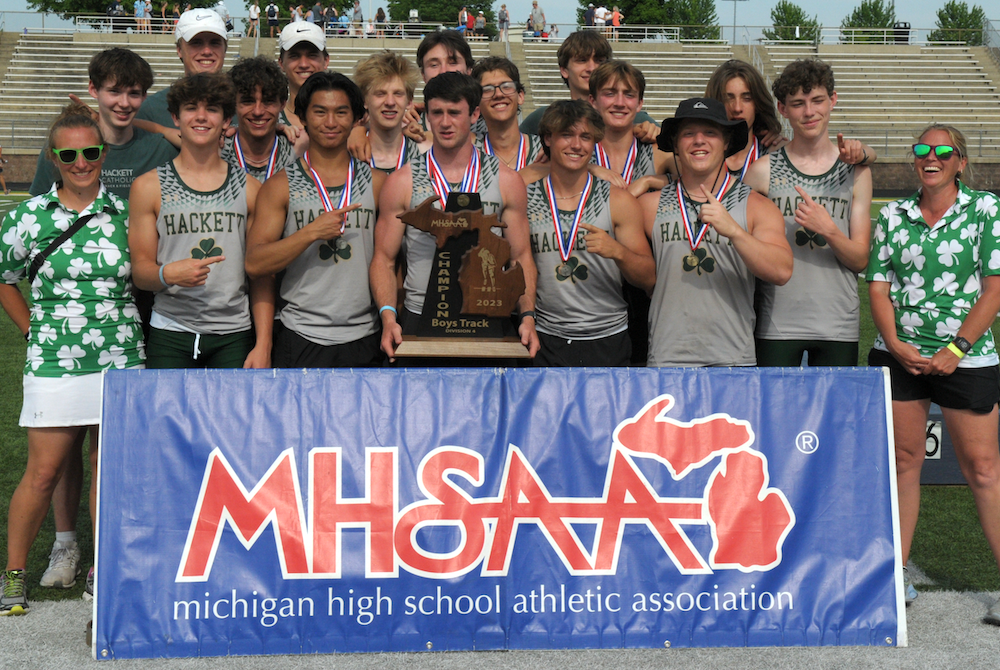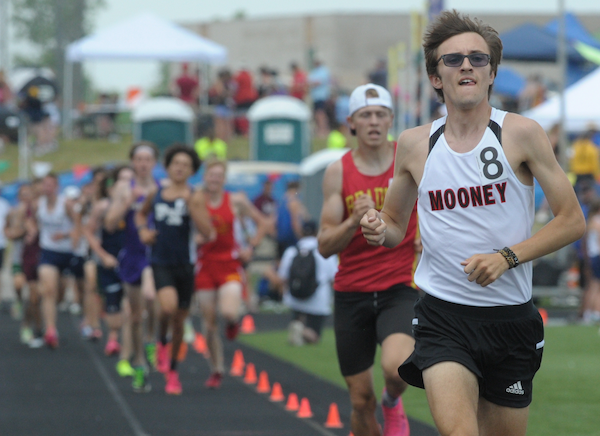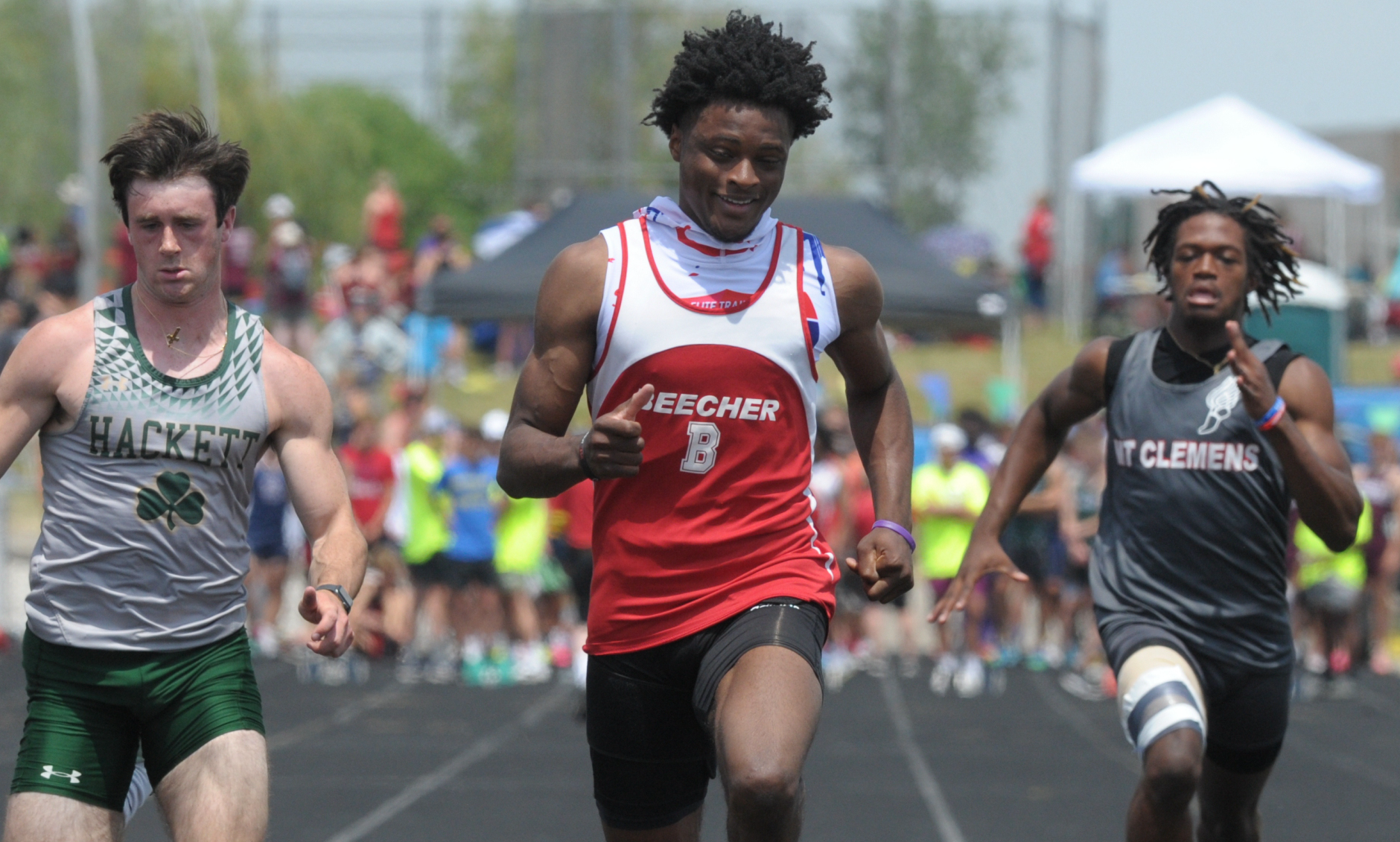
Saugatuck, Dunn Dominate in D4 Repeat
June 4, 2016
By Chip Mundy
Special for Second Half
GRAND RAPIDS – There was little question that Saugatuck junior Blake Dunn was the individual star of the MHSAA Lower Peninsula Division 4 track & field meet Saturday afternoon at Houseman Field.
Dunn swept the 110 and 300-meter hurdles, both in meet-record times, to lead Saugatuck to the championship just one year after the Indians shared first place with Concord. Saugatuck finished with 66 points to easily outdistance runner-up Evart’s 32. Cassopolis was third with 30.
It was Saugatuck’s third MHSAA championship in the past four years, and the Indians were runners-up in 2014.
“The distance guys let me know that we would have won the meet without Blake,” Saugatuck coach Rick Bauer said. “They get tired of my harping at them and asking why they don’t score as much as Blake. We used to be a distance program that ran track, and now we’re a pretty complete team.”
Dunn dominated the 110 hurdles as he set an LP Division 4 Finals record by winning in 14.33 seconds. He won by more than a second while running into a headwind.
“There was nothing I could do about the wind, so I just did the best I could,” he said. “I’m just really glad that I was able to run a good race.”
Dunn’s double came in the 300 hurdles, which he won in 38.31 seconds, another meet record. That victory was by nearly two seconds, and it was his second consecutive MHSAA title in that event.
“Basically, I try to get out as hard as I can and make those guys try to catch me and see what happens from there,” Dunn said. “I just have to hit the hurdles and keep pushing.”
Dunn is one of the top all-around athletes in the state. He was quarterback on the football team, played basketball and already has decided to play baseball at Western Michigan University. In fact, he had to leave his baseball team, which played in the District tournament Saturday, to compete in the track meet.
“It was a hard choice, but I had faith in my baseball guys that they could come out with a couple of wins,” he said. “It’s awesome that the coaches let me play both sports.
“I’ve been playing football, basketball, baseball and track my whole life, and I think it has helped me keep fresh for every season,” he added. ‘They announced a stat that there are fewer injuries for people who play multiple sports, and I think it keeps my muscles relaxed and loose.”
Bauer was thankful that Dunn was able to be on hand at Houseman.
“That’s a kid who throws 90 miles per hour and probably is going to be in the majors someday; that’s great. Thanks,” he said.
Dunn also ran a leg on Saugatuck’s fourth-place 400 relay, joining teammates Jordan Mitchell, Cole Hartman and Jeff Kohlmeyer.
“The 4 by 100 was kind of a surprise,” Bauer said. “We came in fourth, but we beat our school record by a half a second. That’s the sort of thing you hope happens.”
Saugatuck also was second in the 3,200 as Keegan Siefert, Nick Butch, Orlando Carrion and Zachary Pettinga finished in 8:17.84.
While Dunn had the only individual championships for Saugatuck, the team was loaded with plenty of excellent finishes. Perhaps the most inspiring was the second-place finish in high jump by senior Mervyn Auffret, an exchange student from France.
“We didn’t expect him to score at all, and he ended up in second place,” Bauer said. “I didn’t expect that to happen. He had never tried track until this year, and he didn’t know anything about high jump. He also qualified in the hurdles, so he was a great addition to our team.”
Auffret certainly will return to France with some stories to tell.
“I have told all my friends about the high jump and that I’m good at it, but it was really hard at first,’ he said. “I didn’t know much about it. Really, I didn’t know anything.”
Saugatuck had other strong finishes. In the 3,200, freshman Corey Gorgas was second and junior Pettinga was third. Evan Hotary was fourth in the pole vault (12-9), and Xavier Cardona took fourth in the shot put.
The only other individual double-winner at the meet was Santana Scott of Evart. Scott won the 1,600 in 4 minutes, 22.89 seconds and took the 3,200 in 9:42.83.
Other individual champions in the running events were Billy Wojnowski of Big Rapids Crossroads, who edged Montez Brewer of Concord 11.15 to 11.16 in the 100. Freshman Alec Muck of Sand Creek won the 200 in 22.50, Deion Gaston of Cassopolis took the 400 (50.20) and Daniel Mikovits of Concord captured the 800 in 1:58.50.
In the field events, Jacob Kulhanek of Merrill repeated as champion in the pole vault by clearing 13 feet, 9 inches. Southfield Christian sophomore Blake Washington won the high jump at 6-5, just 1 inch higher than Auffret.
Delvon Hines of Melvindale Academy of Business & Technology won the long jump (20-9.25), Paxton Titus of Brighton Livingston Christian took the discus (162-11), and Jacob Lechner of Harbor Springs won the shot put (13-9).
Relay winners included Melvindale ABT in the 400 (43.75), Muskegon Catholic Central in the 800 (1:31.30), Centreville in the 1,600 (3:28.28) and Hillsdale Academy in the 3,200 (8:13.34).
PHOTO: Saugatuck's Blake Dunn clears a hurdle on the way to an individual title while helping his team to the overall championship at Houseman Field. (Photo by Angie Graham/RunMichigan.com.)

Thrower Claims Lone Individual Title to Lead Hackett to Team 3-Peat
By
Tom Lang
Special for MHSAA.com
June 3, 2023
Kalamazoo Hackett Catholic Prep just keeps winning and winning.
This time the Irish took home their fourth title in the last five Lower Peninsula Division 4 Track & Field Finals, on Saturday at Hudsonville.
Hackett’s only individual title was taken by discus winner Nathan Buchmann, a senior, who was fine knowing he was the shortest in stature among all the sizable competitors.
“In the offseason after football I worked out every day, working towards this goal,” he said after getting his medal. “I would say this takes 80 percent technique and 20 percent strength to throw the discus. So, length can help but if you have good technique and are really strong, that will play into it.
“I think we are very balanced throughout the meet today,” he said about teammates that scored points in finishes other than first place. “We have 13 guys here today, and we have people in a lot of the races. But I do not run; I have too short of legs to be a fast runner,” he said with a chuckle.
Buchmann had to work through a hip injury to compete this spring.
“I think the setbacks are what make you strong,” he said. “You can either give up through the setbacks or push forward and become better.”
 Coach Charissa Dean agreed.
Coach Charissa Dean agreed.
“The kids have big hearts,” she said after all the points were totaled and the Irish were on top once again, with 53. “They worked hard. They had a lot of potential when we started the season. And we had a lot of drive to put in the work, and we are happy the results came out the way they did.”
Reading was runner-up at 47 points, followed by Wyoming Potter’s House Christian with 42, then Fowler and Flint Beecher each with 37 points.
Senior Lezawe “Moses” Osterink, of Potter’s House Christian, placed second in 1,600 but took the 3,200 title as defending champ of both. He dominated the latter by lapping the field with a final lap kick that resembled more of a superhero speedster.
“Nobody really took it out that hard at the start,” he said. “There was a freshman (Marek Butkiewicz of Hackett) that tried to get the pace going quick, but me and Dakota (Dykhuis of Montabella) just kind of sat back and gradually pulled him through.
“We took it gradually, and I was just relying that I could kick.”
Kick did he ever. The trio were neck and neck the majority of the race in a grouping ahead of the pack.
“With 400 to go I just tried to go all out,” Osterink said. “I had a lot more left than I thought and I was pleased with the win. Not really the time, but that doesn’t matter, especially this hot out.”
The overall meet was in the low 90s/high 80s heat and searing sun all day. So, race officials allowed the unique opportunity for coaches to spray the runners with water and give them water bottles.
“It was very weird because I’ve never taken water to drink while I’m running, so I didn’t know how that would feel,” Osterink said. “And they were spraying us and hitting us in the face. It was kind of fun.”
Junior Tyler Lenn of Marine City Cardinal Mooney defeated Osterink at his own game in the 1,600.
“I’m feeling great,” Lenn said after grabbing the medal. “I said to a newspaper after one of my races (during the season) I was right where I wanted to be. This has been a long rebuilding process for me since an injury back in the fall, and I set a pretty high goal the day the injury happened. I was telling myself I needed to fulfill what I said I would do at the beginning of last cross country season. And that is what I did today.”
Lenn suffered an ankle sprain from a misstep that turned worse because he kept running through the season on it.
“Coming back from that was pretty tough, but I wouldn’t have it any other way,” he said.  “Perseverance; I said from the beginning what I was going to do. I kept my eye on that target, and no matter the circumstances life threw at me, that I was going to make it happen and I am a man of my word.”
“Perseverance; I said from the beginning what I was going to do. I kept my eye on that target, and no matter the circumstances life threw at me, that I was going to make it happen and I am a man of my word.”
Jaylin Townsend, a senior from Flint Beecher, dominated the short races. He won the 100 dash (10.67) and 200 dash at 22 seconds flat. It was his third 100 win at a Finals.
“I put in a lot of work; I had to three-peat,” he said after the 100. “There’s a lot of great competition here, so I knew I had to come out and run my best.”
Concord in the 400 (43.72), Buckley in the 800 (1:30.76) and 1,600 (3:29.13) and Potter’s House in the 3,200 (8:14.18) were relay champs Saturday. Reading’s Tayshawn Bester won the 110 hurdles (15.13), and Athens’ Landen Bennett won the 300 (39.85). Caseville’s Nathan Feltner won the 400 (50.76), and Vestaburg’s Owen Patton claimed the 800 (1:55.11).
Fruitport Calvary Christian’s Bradley Richards won the high jump (6-10), and Peck’s Alex Affer won the long jump (23-4). McBain Northern Michigan Christian’s Isaac Bowden was first in pole vault (13-0), and Brown City’s Kyle Affer won shot put (49-2).
PHOTOS (Top) Kalamazoo Hackett Catholic Prep celebrates its third-straight LPD4 title Saturday. (Middle) Cardinal Mooney's Tyler Lenn, far right, sets the pace in the 1,600. (Below) Flint Beecher's Jaylin Townsend, middle, crosses the finish first for one of his two sprint championships. (Photos by Ken Swart/RunMichigan.com.)

